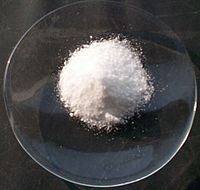
Photo from wikipedia
Trace metal elements are significant stressors in urban areas. Their harmful effects on physiological parameters are demonstrated, but current laboratory studies are not representative of wild chronic exposure to a… Click to show full abstract
Trace metal elements are significant stressors in urban areas. Their harmful effects on physiological parameters are demonstrated, but current laboratory studies are not representative of wild chronic exposure to a trace metal cocktail. Calcium can reduce the accumulation and toxicity of several metals, but soil acidification in cities leads to a decrease in bioavailability of this element. The objective of this study was to investigate the accumulation and toxicity of a trace metal cocktail representative of urban exposure on passerine birds, and test the importance of calcium availability on these toxic effects. We exposed zebra finches (Taeniopygia guttata) to a cocktail of seven metals and one metalloid in drinking water, with or without calcium supplementation. We monitored the concentration of metals in the blood and feathers, and their effects on oxidative status and telomere length. The metal cocktail led to higher concentration of all elements in the feathers, and of arsenic and lead in the blood. Birds with a higher concentration of cadmium, arsenic and lead in the feathers had shorter telomeres, but no impact of the cocktail was detected on oxidative status. Birds of the 'calcium' group and the 'calcium and metal' group accumulated higher concentrations of zinc, chromium and nickel in feathers. The 'calcium and metal' group also accumulated lower concentrations of arsenic and lead in feathers compared to the 'metal' group. Our results suggest that chronic exposure to a cocktail of metals at low concentrations has deleterious effects on birds, which can be limited through calcium intake.
Journal Title: Ecotoxicology and environmental safety
Year Published: 2020
Link to full text (if available)
Share on Social Media: Sign Up to like & get
recommendations!